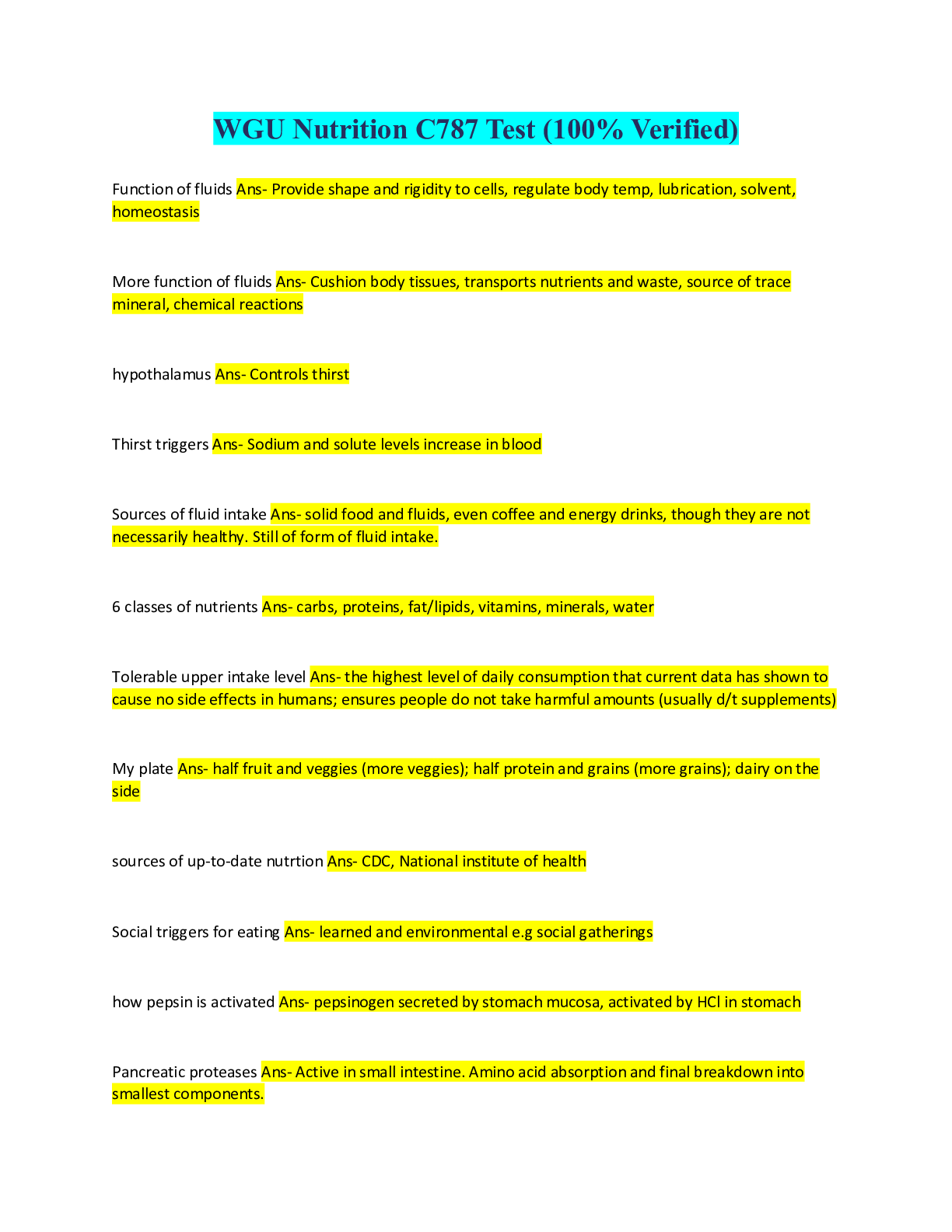Nutrition > QUESTIONS & ANSWERS > WGU Nutrition C787 Test (100% Verified) (All)
WGU Nutrition C787 Test (100% Verified)
Document Content and Description Below
WGU Nutrition C787 Test (100% Verified) Function of fluids Ans- Provide shape and rigidity to cells, regulate body temp, lubrication, solvent, homeostasis More function of fluids Ans- Cushion body ti... ssues, transports nutrients and waste, source of trace mineral, chemical reactions hypothalamus Ans- Controls thirst Thirst triggers Ans- Sodium and solute levels increase in blood Sources of fluid intake Ans- solid food and fluids, even coffee and energy drinks, though they are not necessarily healthy. Still of form of fluid intake. 6 classes of nutrients Ans- carbs, proteins, fat/lipids, vitamins, minerals, water Tolerable upper intake level Ans- the highest level of daily consumption that current data has shown to cause no side effects in humans; ensures people do not take harmful amounts (usually d/t supplements) My plate Ans- half fruit and veggies (more veggies); half protein and grains (more grains); dairy on the side sources of up-to-date nutrtion Ans- CDC, National institute of health Social triggers for eating Ans- learned and environmental e.g social gatherings how pepsin is activated Ans- pepsinogen secreted by stomach mucosa, activated by HCl in stomach Pancreatic proteases Ans- Active in small intestine. Amino acid absorption and final breakdown into smallest components. 2 trigger foods for GERD Ans- coffee and tomato typical manifestation of GERD Ans- chest or back pain when lying down after meal Safe food for celiac disease Ans- Rice; no wheat, rye, or barley. Macronutrients Ans- Carbs, fats, proteins Monosaccharides Ans- glucose, fructose, galactose Starch Ans- 2 or more glucose monomers chained together in plants Glycogen Ans- 2 or more glucose monomers chained together in animals Glucagon Ans- hormone secreted by pancreas that causes the liver to convert stored glycogen into glucose when blood glucose falls too low. sucrose Ans- glucose + fructose lactose Ans- glucose + galactose maltose Ans- glucose + glucose AMDR for carbs, proteins, and fats Ans- half of daily calories should be from carbs, 10-35 % from protein, 20-35% from fat. fiber recommendation Ans- 14 g per 1000 kcal daily whole grain intake Ans- half of all grain products should be whole grain complex carbs Ans- long polysaccharides Added sugars Ans- 25% or less total daily kcals should come from this Trans fats Ans- found in partially hydrogenated oils, unsaturated. Mimic saturated and are usually solid at room temperature Saturated fats Ans- Fully hydrogenated. Long chains, stack well, solid at room temperature Fat Ans- important concentrated source of energy, supports cell growth, maintenance and repair, insulator to maintain constant body temperature. Ideal heart health Ans- diet low in trans and saturated fat Cholesterol Ans- building blocks of steroid hormones Fatty fish Ans- high in omega-3 fatty acids EPA and DHA Plant sources e.g. flax Ans- high in omega-3 fatty acid ALA olive oil Ans- high in monounsaturated fat seeds and nut oils Ans- high in polyunsaturated fats Protein Ans- made up of amino acid and contains nitrogen Dairy product with most protein per serving Ans- Nonfat Greek yogurt Adult intake of protein Ans- 0.8 g per kg of body weight Major functions of protein Ans- provides structure and movement, aids in building enzymes and hormones, acid/base balance, catalyzes cell growth, essential to immune system Complete protein snacks Ans- mature legume product plus grain product. e.g. red beans and rice; hummus and wheat pita; PB and crackers. Protein and fiber Ans- Nutrients that promote a feeling of fullness for longer Non-meat sources for complete protein sources Ans- rice and beans, pasta and veggies with cheeses, tacos with beans, PB sandwich, cereal with milk, couscous with chickpeas. High protein diet risks Ans- High intake of saturated fats Flexitarianism Ans- Eat meat occasionally pasctarian Ans- includes fish vegans Ans- no type of animal product vegetarianism benefits Ans- Decreased risk of obesity, diabetes, GI disorders, cancer, and lower cholesterol levels. vegetarianism risks Ans- low levels of vitamin D, B12, calcium, and omega-3 fatty acids Fat soluble vitamins Ans- vitamins A, D, E, K Vitamin K Ans- Fat soluble, essential in coagulation Thiamin (B1) Ans- deficiency results in beriberi Folate (B9) Ans- deficiency results in macrocytic anemaia Vitamin C [Show More]
Last updated: 1 year ago
Preview 1 out of 8 pages

Reviews( 0 )
Document information
Connected school, study & course
About the document
Uploaded On
May 18, 2022
Number of pages
8
Written in
Additional information
This document has been written for:
Uploaded
May 18, 2022
Downloads
0
Views
94


.png)
.png)
.png)
.png)
.png)
.png)
.png)
.png)
.png)
.png)
.png)

.png)

.png)
.png)
.png)












